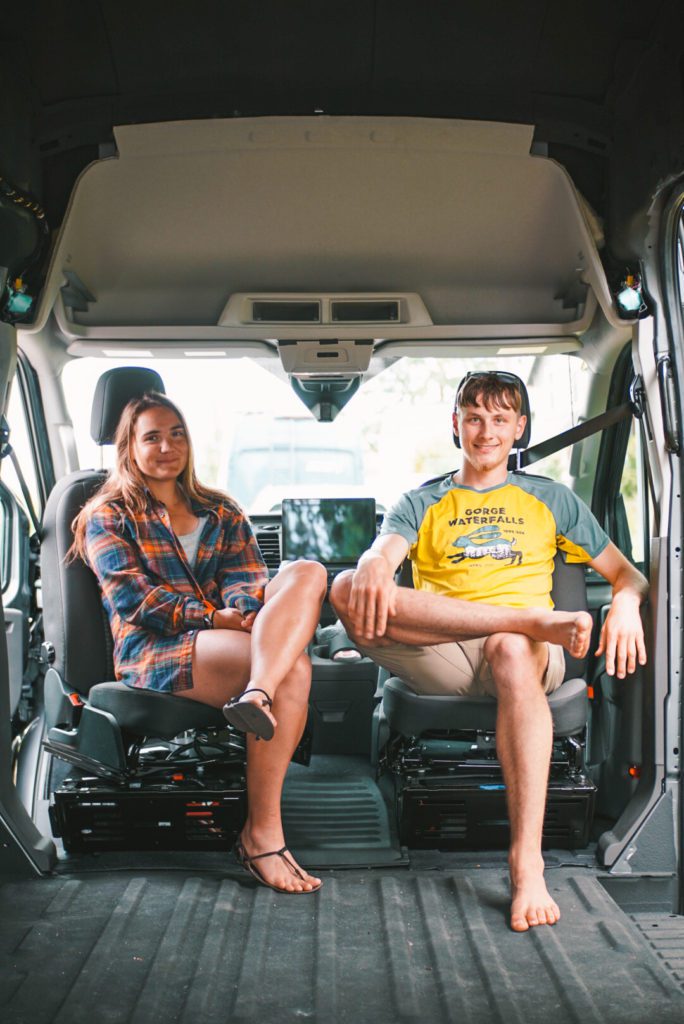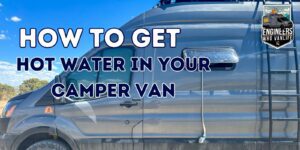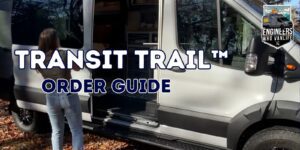Mercedes Sprinter vs. Ford Transit vs. Ram ProMaster - Is there a best camper van for van life?
Choosing the right chassis, or van for van life is complex and requires being honest with yourself about a lot of questions (don’t worry- we have them all below)! However, it is also important to realize that your first camper van doesn’t necessarily have to be your last. Sometimes the best decision for your first van life rig is something strictly within your budget that meets your basic requirements and will allow you to get on the road sooner.
We are on our second camper van, and it wouldn’t be as perfect for us as it is, if we didn’t have a practice camper van. Begin with the considerations below and take into account your current life needs.

** Disclaimer: This blog post contains various affiliate links that provide a small kickback to us, at no additional cost to you. We truly appreciate your support if you choose to purchase through these! **
🎙️ Listen on Van Life Lab Podcast
We recorded this blog post as an episode on our podcast Van Life Lab! If you prefer to listen, or simply want to learn while driving, or walking / running, tune in on your favorite podcast app. We have episodes pertaining to almost everything van life, and DIY van building.
Listen on Spotify
Listen on Apple Podcast
Mercedes Sprinter vs. Ford Transit vs. Ram ProMaster
There are three major chassis that you will see commonly converted to camper vans: Mercedes Sprinter, Ford Transit, and Ram ProMaster. Below, we compare them across various considerations that we have found useful for van life:
- Wheelbase length
- Drive train options
- Roof heights
- Interior widths
- Maintenance
- Cost
- Bonus: #RealLife comments
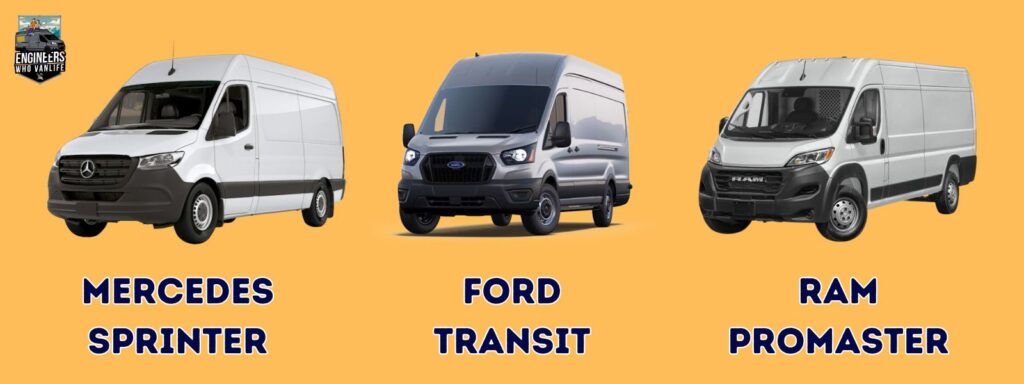
Wheelbase Lengths
Ford Transit: 148″, 148 EXT
Mercedes Sprinter: 144″, 170″, or 170 EXT
Ram ProMaster: 136″, 159″, 159 EXT
Wheelbase is the measurement from axle to axle, or from the middle of the front tire to the middle of the back tire. What does this mean for van life?
- Maneuverability: Generally, a shorter wheelbase is easier to drive. Shorter wheelbases tend to drive, and turn, most similarly to standard cars.
- Comfortability: A longer wheelbase can create a more comfortable ride as there is more time between when your front and rear tires hit an obstacle.
- Departure angle**: Any length that hangs off the back axle will decrease your departure angle. Departure angle matters when climbing up a steep slope. As you decrease your departure angle, it becomes more common to scrape your van tail on the ground and you go up steep slopes.
Drive Trains
Ford Transit: RWD or AWD (2020+)
Mercedes Sprinter: RWD or 4X4
Ram ProMaster: FWD only
2WD (two wheel drive) includes FWD (front wheel drive) and RWD (rear wheel drive). This means that at any given time, power is given to 2 wheels – your front 2 wheels with FWD and your back 2 wheels when RWD. While this drives great on the highway and standard road conditions, it will struggle in snowy / sandy environments.
AWD (all wheel drive) means power is given to all 4 tires, all of the time and performance is much better in snow, sand, and off road. This is in contrast to 4X4 which allows you to manually switch between 2WD for more efficiency on highway and four wheel drive in off road conditions.
4X4 also allows you to lock your four tires together which by far creates the best performance in serious off road conditions. However, because of the nature of camper vans (hey – your house is back there), van lifers don’t typically need the benefits of a proper 4X4 system, AWD is just fine.
A quick note on dimensions
Below we share some key dimensions. We want to note that these can vary within an inch depending on the source of the measurements. Do not use the following dimensions to a tee, instead take them into account generally.
To provide context, the dimensions we used here are from the following sources and are both videos so you can see where the measurements were taken:
- Ford Transit Dimensions from Waldoch & Katie and Joe
- Sprinter vs ProMaster Dimensions from Humble Road & Upfit Supply
We always suggest taking your own measurements as the first stage of your planning.
Roof Height / Interior Standing Height
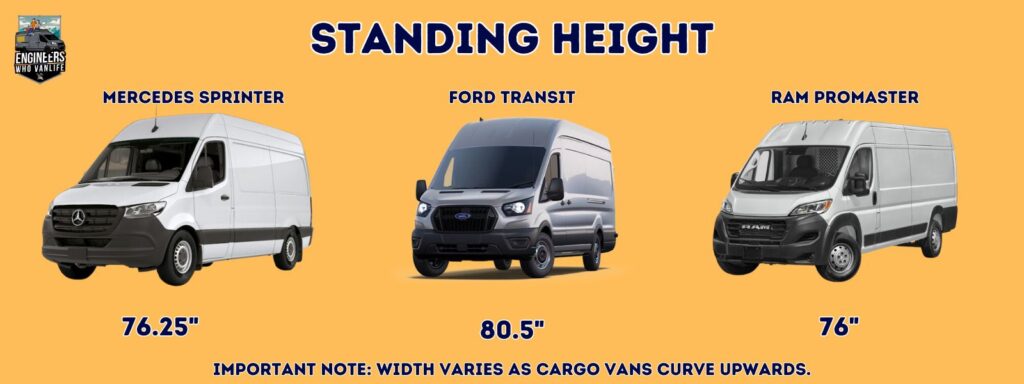
Ford Transit: mid = ~72″ high = 80.5″
Mercedes Sprinter: low = ~67.7″ high = 76.25″
Ram ProMaster: low = ~65″ high = 76″
If you are planning to be a full time van lifer, you will want to stand up fully inside your camper van. However, if you are building a weekend adventure mobile, you might be willing to compromise on the interior standing height! It is important to realize that you will lose anywhere from .5 – 2+” from the top and bottom due to subfloor and ceiling.
We also want to bring attention to vehicle height clearance. The taller the van you choose for van life, the more you will need to be aware of clearance restrictions. Generally, in North America you will not need to worry, but, if you plan to travel across seas, or do the PanAmerican Highway clearance will be a concern. Additionally, if you ever need to ship your van in a shipping container, there are height restrictions there.
Related Reading: Camper Van Subfloor Options
Chassis Interior Width
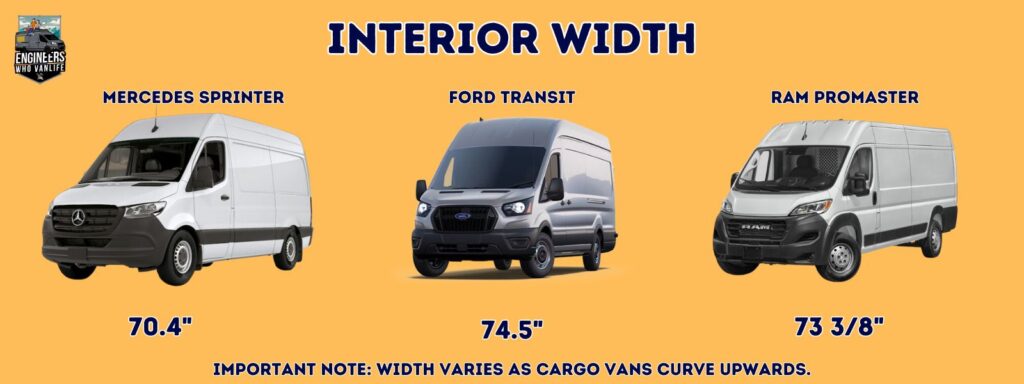
Ford Transit: 74.5″ at widest workable width (beam to beam)
Mercedes Sprinter: 70.4″ at widest workable width (beam to beam)
Ram ProMaster: 73 3/8″ at widest workable width (beam to beam)
These measurements vary because cargo vans curve upwards (see more on this below). Our favorite way to make camper van wider is to add Flares. These are an easy DIY project and add 4-6″ of width.
Related Reading: How to Install Camper Van Walls
Related Reading: How to DIY Install Flares
Curvature
All cargo vans have a curve to the walls that makes van building harder. It is hard to square things against curved walls. This is one of the main reasons we love van building with extruded aluminum – everything naturally squares. Ram ProMasters are the most boxy of the cargo vans which makes them a common choice for beginner builders. The Mercedes Sprinter is by far the most curved which not only presents difficulty, but also lost space. Ford Transit lies in the middle.
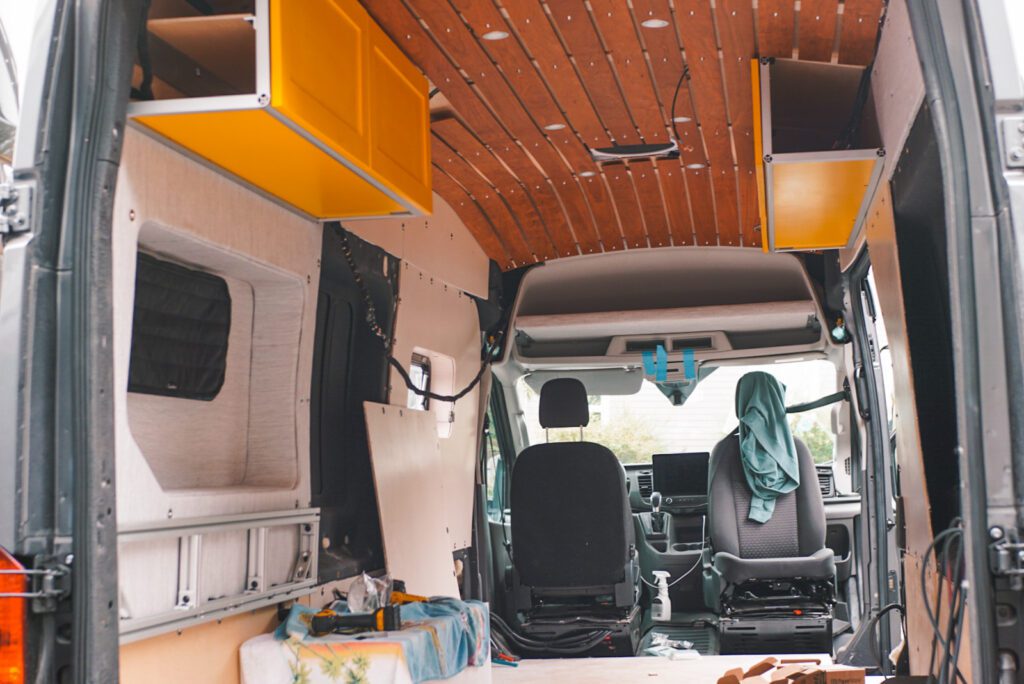
Maintenance
Ford Transit: By far easiest to maintain and service. All mechanics will pretty much work on them. Ford vehicles are known to be extremely reliable.
Mercedes Sprinter: Very expensive to service and hard to find locations willing to service them.
Ram ProMaster: Middle of the ground. Transmissions are commonly known to go out early on ProMasters.
Cost
In order of new vehicle cost from lowest to highest:
- Ram ProMaster
- Ford Transit
- Ford Transit Trail (more info below)
- Mercedes Sprinter
Tidbits we Have Heard on the Road
All of the above are facts and numbers. How these common chassis actually perform as camper vans can vary. So, we’ve compiled some other random tidbits we have heard from our 2.5+ years on the road.
Ram ProMaster:
- Most uncomfortable to sit in! They were first built for quick trips around town (think plumbers!) so the seats are very uncomfortable for long drives.
- Easiest to step into. ProMasters have a “step up” between the cargo and the front space. This greatly shortens the step into the van. This is in contrast to how the Transit has a flat cargo to front transition, which leaves a large step into the van.
- Most mice! No kidding. ProMasters have so many exposed entries that mice, and other rodents, frequently take up residence in ProMasters.
Ford Transit
- “Drives the most like a regular car”
- EcoBoost engine is a huge plus.
- Servicing and maintenance is an absolute breeze, and roadside assistance is just a easy as almost all mechanics work on them.
Mercedes Sprinter:
- We know many people who have been towed 200+ miles due to lack of maintenance centers.
- Natively perform best in off road conditions without upgrades.
Other Considerations for Choosing a Van for Van Life
Below we address some of the important questions to ask yourself that will help you narrow down what van is best for your van life. These questions are not specific to the 3 chassis above.
Ford Transit Trail™ - 2024 Update
Additional Chassis Options
The three chassis above are not your only options! Some other great base chassis for van life to keep in mind include:
- School Busses
- Budget friendly
- Great for families of if you prefer more space
- Harder to off road in
- Generally have great maintenance records
- Retired Ambulances
- Harder to find
- Easy to build in due to the box like structure
- Other cargo vans
- Truck Campers
- Smaller
- Easier to take off road
- Recreational Vehicles (RV)
- Come fully built out
- Harder to boondock in as they require hookups and are not built for off roading
- Box Trucks
- Great if you want more space.
- Higher cost
- Can be great for off roading if done right
You are really only limited by your imagination. In Alaska, we saw a semi truck converted into a home!
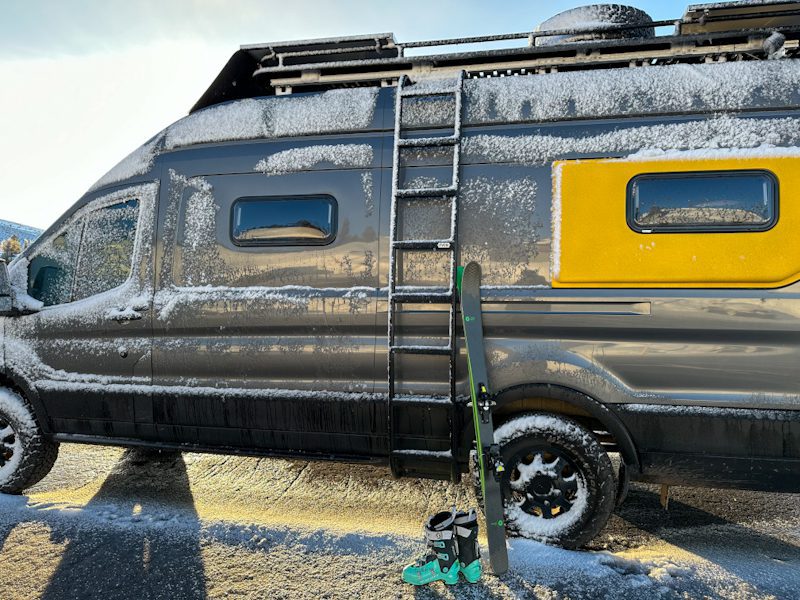
Are you pursuing full time or part time van life?
The number one question to ask yourself when choosing a camper van is: do you want to do van life part time, or full time? Below, we share considerations that each option opens up.
Van Considerations for Full Time Van Life
- Permanent and larger storage. Generally full time van lifers carry everything they own, all the time.
- Your layout must accommodate everything you need to live every day normally including workspaces, ability to cook full meals, and a comfortable bed.
- Ergonomic modules. When you live in a camper van full time, you need to be comfortable, so extra effort must be placed into an ergonomic layout.
Van Considerations for Part Time Van Life
- Less storage space (gear, clothes, etc). You only need to throw into your camper van what you need for that particular trip.
- You don’t need to fit everything into your layout. You might be able to get away without a workspace, or a simpler kitchen setup, or a smaller bed.
- Generally you will be able to fill water, and charge your batteries at home, so you can get away with less capacity for both.
Related Reading: Camper Van Electrical Audit
How many people (& pets) are you travelling with?
The number of people, and pets, that are traveling in your camper van will determine the size, and number of legal seats in you need in your camper van. Generally 2 people and a pet, or two, can fit comfortably in a camper van; however, as the numbers grow, the rigs also grow. Some examples of larger rigs include:
- School Busses
- Box Trucks
- Ambulances
Should you get a used or a new camper van?
This can be a tough question; however, we have a starting point for you! When deciding if you should buy a used, or new van, for you camper van conversion, we recommend deciding your budget up front. From there, we recommend spending about .5 – 1x your empty chassis cost on your conversion.
Say you can want to spend $5,000 on the conversion piece of your van build. By the calculation above, we recommend spending up to $10,000 on your empty chassis.
Used Van Considerations
Used vans are generally cheaper and quicker to source. However, there are more unknowns to accommodate for than a new van.
New Van Considerations
New vans are more reliable, have minimal unknowns, include a warranty, and generally are easier to source parts for. However, they are more expensive and wait times can be long.
Gas vs. Diesel Fuel
Generally, gas engines put out more horsepower but have a lower towing capacity.
Diesel engines take a longer time to get up to speed and have a harder time getting up steep mountain passes. Towing capacity is better. Diesel engines are known to last much longer than gasoline engines and get better fuel economy.
Winter considerations for Diesel: Diesel is made of hydrocarbons that begin to gel at 40F and below. This will make it tough to start and effect your camper van heater functionality! You can buy a “winter mix” of diesel that has a lower freezing point, but it is not winter proof completely.
Other country considerations: Diesel can be tougher to find in other countries, or will have water added. If you have a newer diesel engine that requires DEF, this could be difficult.
Related Reading: Camper Van Heater Options
Bonus: Is the Transit Trail a good van for Van Life?
The Transit Trail is Ford’s version of a chassis built specifically for van life. It is at a slightly higher price point than the standard Transit that comes with:
- 2″ lift
- Bigger tires (30 inch vs 28 inch)
- Increased track width for greater stability
- Side Step
- Other aesthetic improvements (marker lights, roof fans, grill, etc).
We love this nod to van life from Ford! However if the higher price point, or wait times are a concern, here is what we did to our rig to get it to almost the same place:
- Quigley Q Lift (maintains factory warranty)
- Bilstein Struts & Shocks (done with QLift)
- Sway Bar (done with QLift)
- 30.5″ BF Goodrich kO2 A/T tires (we trimmed the pinch weld)
The side step and increased track width are two functional things we don’t have.
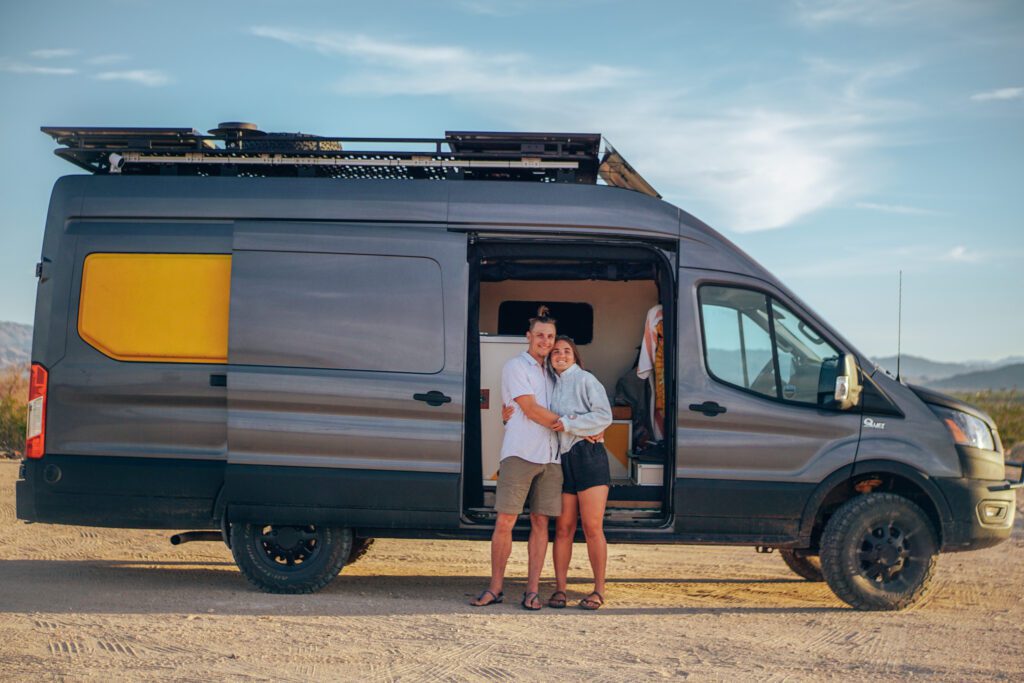
Choosing a Van for Van Life
Choosing the right van for van life can be overwhelming. However, if you take into account the considerations above with your own personal life needs, you are off to a great start! Truthfully, you can make a lot of options work, how you build the inside out will matter the most. Happy Building!
Start Here -> Step by Step: How to Build out a Camper Van
Thanks for being here! Happy building!
Eric + Colby
✉️ Join our mailing list for more content!
🙏🏽 If you are looking for more 1:1 van build help, we are here to help via Consulting or Travel Van Building.
[Start Here] Beginner Guides:
